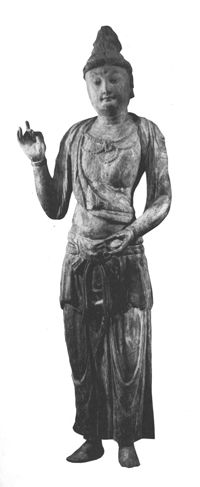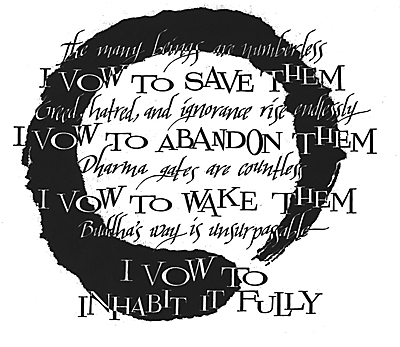The Great Vows, known as the Bodhisattva Vows, probably originated in China around the sixth century and may have been derived from an earlier Sanskrit gatha (a four-line verse that sums up an aspect of the dharma, and is often a vow). At the turn of the eighth century we find Chinese Zen master Hui-neng teaching their implications. Today they are recited at the end of services in most Mahayana centers.
Composed with seven Chinese graphs per line, the Great Vows are poetically arranged in parallels, rhymes, and repetitions. The contemporary English translations of the Great Vows rely heavily on D.T. Suzuki’s version, first published in 1935. He used the title “The Four Great Vows,” an abbreviation of the title used by Hui-neng: “The Four Broad Great Vows.” The graph for “broad” implies “for broad dissemination.” Nakagawa Soen Roshi (1908-83) in turn established the title “Great Vows for All” for his own translation in 1957, and two years later, at the Diamond Sangha—then a fledgling community in Honolulu—we used this title in our first sutra book. Today, as we continue to refine our translation, it is almost the only part of the wording of the Vows that has stayed the same.
The four Great Vows express aspirations relating to the Three Treasures of Buddhism: to redeem the sangha, to stop debasing the Three Treasures, to perceive the dharma clearly, and to attain buddhahood. As such, the Vows are a recasting in the Mahayana of the Ti-sarana-gamana, the ceremony of taking refuge in the Three Treasures, that is found in all Buddhist traditions.
Shu jo mu hen sei gan do
The many beings no limit pledge vow carry across
The many beings are numberless; I vow to save them.
Shu means “the many,” or “all.” Jo is literally “birth” or “spring up,” and is the term for “a being” or “existence.” The compound shujo, “the many beings,” is an expanded translation of the Sanskrit sattva, which also means “a being” or “existence.” Shujo, “the many beings,” includes “the vegetable kingdom,” as Soothill and Hodous remark in their Buddhist dictionary, but my reading would have “the many beings” include all things that exist.
In other contexts, one finds a compound pronounced ujo, “with sentience,” used as a translation of sattva. Ujo confines the meaning of “beings” to “the animal kingdom”—or more probably just to humanity. But it is shujo, “the many beings,” not ujo, that we find in the Great Vows. Our East Asian ancestors clearly intended to be all-encompassing; using “sentient beings” in this context, as some Western centers do, sets anthropocentric limits to our bodhisattva spirit.
Do is a translation of the Sanskrit paramita, which has two possible meanings. The first is “perfection”—the state and the practice—and the second is “to cross over.” Do follows this second interpretation, and is causative: “enable” (them) to cross over. Some dharma centers use “enlighten them” and—although bushes and grasses are evolving toward anuttara-samyak-sambodhi—the implication of human realization in the word “enlighten” seems, once again, to exclude the nonhuman.
Beginning students commonly ask how they can honestly vow to save all beings. It sounds like missionary arrogance. Hui-neng offers a response: “You are saving them in your own mind.” It is bodhicitta that you are cultivating—your own aspiration for wisdom and compassion, and your determination to practice it in the world as best you can.
bon no mu jin sei gan dan
grief distress no exhausting pledge vow conclude
greed, hatred, and ignorance rise endlessly; I vow to abandon them.

The Japanese word bonno translates the Sanskrit klesha, “pain, affliction, distress,” and this term is interpreted by the Chinese Buddhists as “delusions, trials, or temptations of the passions which disturb and distress the mind”; also in brief as the “Three Poisons.” The Three Poisons are “greed, hatred, and ignorance,” and we settled on this interpretation as the most specific. “Obstacles” seemed to lack specificity, while the use of “passions” and “desires” echo Calvinism rather than Buddhism. Without “passions” we’d be the walking dead, and without “desires” we wouldn’t even be walking. Dan means “conclude, dismiss, cut,” and is rendered “cut them off” in some Western versions. One community member suggested that while “cut” has a precedent, it seemed macho. Instead we chose “abandon them,” which implies that these actions were formerly esteemed—which they were.
Like the first, this second line is about one’s own mind. It expresses the aspiration to “cut off the mind road,” in Wu-men’s terminology, to cut the tape of incessant chatter, the internal monologue that inevitably relates to “how I am, how I was, how I will be.” In the silence that follows, one turns naturally to the well-being of others, as the Buddha turned his mind to his five disciples in Benares when he cut his own incessant tape.
ho mon mu ryo sei gan gaku
dharma gates no measure pledge vow learn
dharma gates are countless; I vow to wake to them.
When our sangha first wrestled with the wording of the vows sixteen years ago, Stephen Mitchell, who was translating The Book of Job at the time, suggested that we use the expression “vast and fathomless,” which appears in Job’s first response to Bildad the Shuhite. We omitted the troublesome “gates,” and rendered the line, “Though the dharma is vast and fathomless.” But in our new version we have reinstated the “gates” because they really are dharma openings—our chances for realization of the myriad things that advance and confirm us—when we are open to them.
Another problem with this line lies in the word gaku, “learn” or “study,” the graph found in compounds that means “school,” “institute,” and “student.” It is usually translated “understand” or “master,” neither of which conveys the idea of “being receptive to,” which gaku seems to suggest here. After all, how does one master or understand an opportunity! This line recalls Zen master Bassui’s challenge: “Who is hearing that sound?” When you are receptive and not lost in thoughts, that sound, touch, glimpse, or scent is your great chance.
Butsu do mu jo sei gan jo
Buddha way no top pledge vow become
Buddha’s way is unsurpassed; I vow to embody it fully.
Butsu is “Buddha” and do is “Tao,” so Butsudo is the Buddha Tao or Buddha dharma, the Way of the Buddha, and the practice of Buddhism. More fundamentally, it would be perennial practice, as set forth by the Buddha and his successors.
Mujo is literally “no higher,” with jo meaning “top.” Gary Snyder translated this line, “Buddha’s way is endless, I vow to follow through.” In our first seminar, we had a hard time with jo. After some discussion, we settled on “embody,” and we added “fully” to give the Vows a feeling of completion.
This final line is our vow to walk the Eightfold Path of the Buddha as rigorously and as nobly as he did. This is the Way that begins with Right Views: clear insight into the insubstantial nature of the self and all things, the innate harmony of the universal organism, and the uniqueness of each individual being. It then extends to the application of these Views in thoughts, words, conduct, livelihood, lifestyle, recollection, and meditation.
Thank you for subscribing to Tricycle! As a nonprofit, we depend on readers like you to keep Buddhist teachings and practices widely available.
